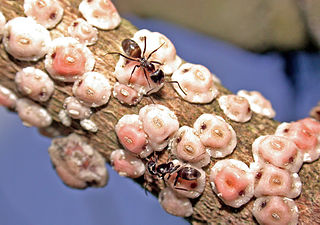
Dorylus, also known as driver ants, safari ants, or siafu, is a large genus of army ants found primarily in central and east Africa, although the range also extends to southern Africa and tropical Asia. The term siafu is a loanword from Swahili, and is one of numerous similar words from regional Bantu languages used by indigenous peoples to describe various species of these ants. Unlike the New World members of the former subfamily Ecitoninae, members of this genus form temporary subterranean bivouacs in underground cavities which they excavate and inhabit - either for a few days or up to three months. Also unlike some New World army ants, driver ants are not specialized predators of other species of ant, instead being more generalistic with a diet consisting of a diversity of arthropods. Colonies are enormous compared to other army ants and can contain over 20 million individuals. As with their American counterparts, workers exhibit caste polymorphism with the soldiers having particularly large heads that power their scissor-like mandibles. They are capable of stinging, but very rarely do so, relying instead on their powerful shearing jaws. Driver ant queens are the largest living ants known, with the largest measuring between 40 - 63 millimeters in total body length depending on their physiological condition.

Dolichoderinae is a subfamily of ants, which includes species such as the Argentine ant, the erratic ant, the odorous house ant, and the cone ant. The subfamily presents a great diversity of species throughout the world, distributed in different biogeographic realms, from the Palearctic, Nearctic, Afrotropical region and Malaysia, to the Middle East, Australian, and Neotropical regions.

Dorymyrmex is a genus of ants in the subfamily Dolichoderinae.

The wildlife of Tunisia is composed of its flora and fauna. It has 84 species of mammals and 375 species of birds. Tunisia is well documented for its addax and Dama Gazelle population.

Aphaenogaster is a genus of myrmicine ants. About 200 species have been described, including 18 fossil species. They occur worldwide except in South America south of Colombia, sub-Saharan Africa, and Antarctica.

Crematogaster is an ecologically diverse genus of ants found worldwide, which are characterised by a distinctive heart-shaped gaster (abdomen), which gives them one of their common names, the Saint Valentine ant. Members of this genus are also known as cocktail ants because of their habit of raising their abdomens when alarmed. Most species are arboreal (tree-dwelling). These ants are sometimes known as acrobat ants.

Bothriomyrmex is a genus of ants in the subfamily Dolichoderinae.

Carebara is a genus of ants in the subfamily Myrmicinae. It is one of the largest myrmicine genera with more than 200 species distributed worldwide in the tropics and the Afrotropical region. Many of them are very tiny cryptic soil and leaf-litter inhabitants. They nest in rotten wood to which the bark is still adherent in the Afrotropical region, or may be lestobiotic nesting near other ant species. Some species are known to exist parasitically within termite nests. Little is known about the biology of the genus, but they are notable for the vast difference in size between queens and workers.
Fulakora is a genus of ants in the subfamily Amblyoponinae. The genus has a worldwide distribution, and like most other amblyoponines, Fulakora species are specialized predators. It was originally described as, and for a long time considered to be, a subgenus of Stigmatomma until it was elevated to an independent genus by Ward & Fisher (2016).

Bothriomyrmecini is a tribe of Dolichoderinae ants with 5 genera.
Bothriomyrmex breviceps is a species of ant in the genus Bothriomyrmex. Described by Santschi in 1919, the species can be found in Tunisia and Algeria.
Bothriomyrmex communistus is a species of ant in the genus Bothriomyrmex. Described by Santschi in 1919, the species is endemic to various countries of Europe and Asia, including Albania, Armenia, Bulgaria, Czech Republic, Georgia, Greece, Italy, Montenegro, Slovenia and Ukraine.
Bothriomyrmex corsicus is a species of ant in the genus Bothriomyrmex. Described by Santschi in 1923, the species is endemic to various European countries, including Austria, Bulgaria, Czech Republic, France, Greece, Hungary, Italy, Liechtenstein, Monaco, Montenegro, Romania, Serbia, Slovakia, Slovenia, Spain, Switzerland, Turkey, Ukraine.
Bothriomyrmex crosi is a species of ant in the genus Bothriomyrmex. Described by Santschi in 1919, the species is found in Algeria, Morocco, and Tunisia.
Bothriomyrmex cuculus is a species of ant in the genus Bothriomyrmex. Described by Santschi in 1919, the species is endemic to Algeria and Tunisia.
Bothriomyrmex decapitans is a species of ant in the genus Bothriomyrmex. Described by Santschi in 1911, the species is endemic to Algeria and Tunisia.
Bothriomyrmex emarginatus is a species of ant in the genus Bothriomyrmex. Described by Santschi in 1911, the species is endemic to Tunisia.
Bothriomyrmex pubens is a species of ant in the genus Bothriomyrmex. Described by Santschi in 1919, the species is endemic to Algeria and Tunisia.
Bothriomyrmex regicidus is a species of ant in the genus Bothriomyrmex. Described by Santschi in 1919, the species is endemic to Algeria and Tunisia.

Two Kinds of Women is a lost 1922 American silent Western film directed by Colin Campbell and starring Pauline Frederick. It is based on the novel Judith of Blue Lake Ranch by Jackson Gregory. Robertson-Cole produced the film and distribution was through Film Booking Offices of America.










